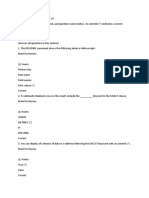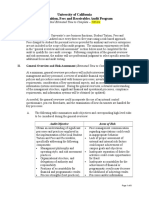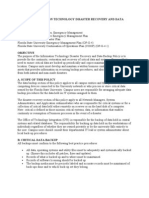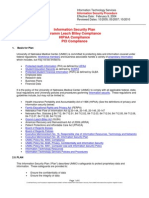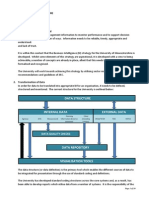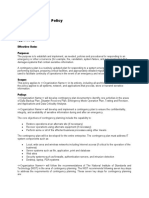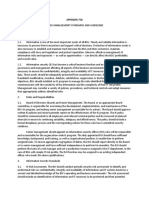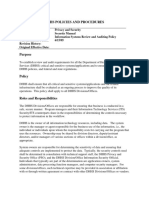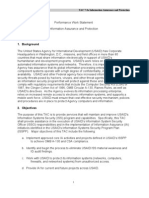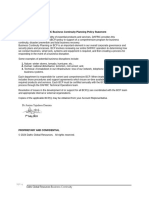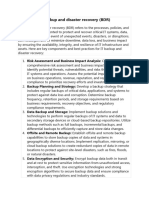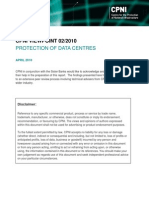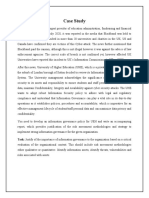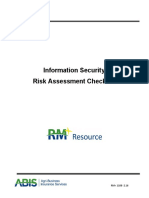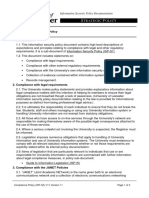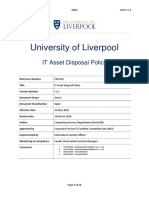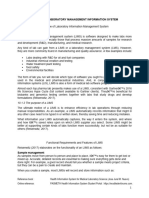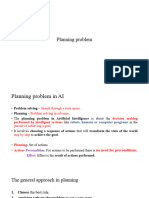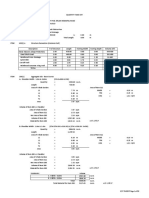Purpose
Purpose
Uploaded by
ferrifiamCopyright:
Available Formats
Purpose
Purpose
Uploaded by
ferrifiamOriginal Title
Copyright
Available Formats
Share this document
Did you find this document useful?
Is this content inappropriate?
Copyright:
Available Formats
Purpose
Purpose
Uploaded by
ferrifiamCopyright:
Available Formats
Virginia State University
Policies Manual
Title: Business Impact Analysis Policy Policy: 6130
Purpose
The purpose of this policy is to ensure that the University will conduct, develop, and maintain a
viable business impact analysis that will identify their business functions, those business
functions that are essential to the University's mission, and identify the IT resources that are
required to support these essential functions.
Authority, Responsibilities and Duties
These roles and responsibilities a r e assigned to individuals, and may differ from the actual role
title or working title of the individual's position. Individuals may be assigned multiple roles, as
long as the multiple role assignments provide adequate separation of duties, provide adequate
protection against the possibility of fraud, and do not lead to a conflict of interests. Refer to
Information Security Policy 6110 for roles and responsibilities.
A. System Owners
Systems Owners are required to participate in the development of the University's Business
Impact Analysis (BIA). Additionally, for each mission essential function (MEF) and primary
business function (PBF), these individuals will assess whether the function depends upon an IT
system for recovery. Each system that is required to recover an MEF or PBF shall be considered
sensitive relative to availability. For each system classified as "Sensitive", S yst e m Owners are
required to establish recovery time objectives (RTO) and recovery point objectives (RPO). The
resources required to support each MEF and PBF must be identified as well. Lastly, the System
Owners reviews and approves the BIA.
B. Data Owners
Data Owners must also participate in the development of the University's Business Impact
Analysis (BIA) to establish recovery time objectives (RTO) and recovery point objectives
(RPO). Additionally, these individuals must identify the type(s) of data handled by each
University IT system for which they are the data owner, determine whether each type of data is
also subject to other regulatory requirements, and determine the potential damages to the
University due to a compromise of confidentiality, integrity, or availability of each type of data
handled by the IT system, and classify the sensitivity of the data accordingly.
C. University Executives and Senior Management
University Executives and Senior Management in Academic and Business units of the University
are responsible for and must participate in the development of the University's Business Impact
Analysis (BIA) to ensure that recovery time objectives (RTO) and recovery point objectives
(RPO) are established for the systems and data handled by all the University IT systems within
their purview. These i n d i v i d u a l s a r e also r e sp o n si b l e f o r establishing o v e r a l l
p r i o r i t i e s for
Revision Date: March 10, 2016 Page No: 1
Virginia State University
Policies Manual
Title: Business Impact Analysis Policy Policy: 6130
recovery of systems and data and periodic review (at least annually) of the BIA to adjust
RTO/RPO and priorities. University Executives shall approve the final BIA prioritization list.
Roles and Responsibilities
1. Business Impact Analysis (BIA) delineates the steps necessary for VSU to identify the
business functions, identify those business functions (e.g. Primary Business Functions -
PBFs) that are essential to the University's mission (Mission Essential Functions - MEFs),
and identify the resources that are required to support its essential business functions.
2. VSU Department of Police and Public Safety (DPPS) department is the COOP Coordinator
for the University as required in the COOP planning guide by the Virginia Department of
Emergency Management (VDEM).
3. It is the policy of the University that the Technology Services department in conjunction
with academic and business departments, will develop, document and maintain appropriate
policies, standards, and specific written processes and procedures to address Continuity
Plan, IT Disaster Recovery Planning, and IT Systems and Data Backup and Restoration.
4. Designate an employee to collaborate with the VSU COOP coordinator as the focal point for
IT aspects of COOP and related Disaster Recovery (DR) planning activities and DR training
and DR test exercises.
5. Based on results of the Business Impact Analysis (BIA) and Risk Assessments (RA), develop
IT disaster recovery components of the University COOP which identifies:
a. Each IT system that is necessary to recover business essential functions or
dependent business functions and the Recovery Time Objective (RTO) and
Recovery Point Objective (RPO) for each; and
b. Personnel contact information and incident notification procedures.
c. Require an a n n u a l exercise (or more often as necessary) of the VSU COOP
and IT DR components to assess the adequacy and effectiveness of the plan; and
d. Require review and revision of IT DR components following the exercise (and at
other times as necessary).
5. The VSU COOP and IT DRP must be approved by the University President.
6. Periodically review, reassess, test, and revise the VSU COOP and IT DRP to reflect
changes in essential business functions, services, IT system hardware and software, and
personnel.
7. Establish communication methods to support IT system users' local and remote access to
IT systems, as necessary.
8. The Data Backup and Restoration plan must ensure that data and systems can be
recovered and information technology services can be resumed following an event
causing the loss of data. The University and its business partners will operate within
generally accepted best practices for backup and restoration to include, but not be limited
to:
a. Secure off-site storage for backup media.
Revision Date: March 10, 2016 Page No: 2
Virginia State University
Policies Manual
Title: Business Impact Analysis Policy Policy: 6130
b. Store off-site backup media in an off-site location that is geographically separate
and distinct from the primary location.
c. Ensure performance of backups is conducted only by authorized personnel.
d. Review of backup logs after the completion of each backup job to verify
successful completion.
e. System Owners approve backup schedules of the systems they own.
f. System Owners approve emergency backup and operations restoration plans o f
the systems they own.
9. Any backup media that is sent off-site (physically or electronically) are picked up by Iron
Mountain or any commercial cannier, must be protected in accordance within the
University's IT security requirements.
I 0. Authorization and logging of deposits and withdrawals of all media that is stored off-site
is required.
II. Retention of the data handled by an IT system must be in accordance with the State
Library of Virginia records retention policies and procedures.
12. The University's management of electronic information must be performed in such a way
that it can be produced in a timely and complete manner when necessary, such as during
a legal discovery proceeding.
13. IT system and data backups and restoration must be tested on a periodic basis to ensure
backups are functioning as expected and the data can be restored in a usable form.
14. For systems that are sensitive relative to availability, recovery of the system and data will
be tested based on disaster recovery procedures and in accordance with VSU COOP Plan.
Policy Statement
This Business Impact Analysis policy applies to all University employees (permanent,
temporary, contractual, faculty, administrators and students) who use VSU information
technology resources to conduct University business.
I. It is the policy of the University that it will develop and periodically update, the business
impact analysis to ensure that the recovery time objectives (RTO) and recovery point
objectives (RPO) for essential business functions and dependent functions that rely upon IT
resources, are identified and documented. The information will be used as input to the IT
Systems and Data Sensitivity Classification, Risk Assessments, IT Contingency Planning,
and IT System Security Plans.
2. Exceptions to this Policy
Revision Date: March 10, 2016 Page No: 3
.
' Virginia State University
Policies Manual
Title: Business Impact Analysis Policy Policy: 6130
Exceptions to this policy will require a documented request that details the business case for the
exception, specifically what requirement the exception is for, and what mitigating controls will
be implemented to protect the University. Refer to Information Security Policy 6110 for the
requirements and process to file an exception.
3. Violations of Policy
Violation of this policy may result in disciplinary action under the Virginia Department of
Human Resources Policy 1.60, Standards of Conduct (4116/08, 611111).
References
Virginia Information Technology Agency (VITA):
Information Security Standard (SEC 501-09) (02/20/2015)
IT Contingency Planning Guideline (SEC 508-00) (04118/07)
IT Security Audit Standard (SEC502-02.2) (01/06/2013)
Revision Date: March 10, 2016 Page No: 4
You might also like
- Technical Proposal For IT AuditDocument24 pagesTechnical Proposal For IT Auditkhandobha100% (1)
- Uptime Institute - Tier StandardsDocument16 pagesUptime Institute - Tier StandardsBK180100% (4)
- Quiz 6 L5-L9Document131 pagesQuiz 6 L5-L9Rio Ardayana67% (9)
- Lab4 IAP301Document15 pagesLab4 IAP301thuyptmhe171100No ratings yet
- ETGRMDocument38 pagesETGRMThe Bearded Guy (TheBeardedGuy)No ratings yet
- Auditing Information Systems: Enhancing Performance of the EnterpriseFrom EverandAuditing Information Systems: Enhancing Performance of the EnterpriseNo ratings yet
- University of California Student Tuition, Fees and Receivables Audit ProgramDocument8 pagesUniversity of California Student Tuition, Fees and Receivables Audit ProgramAlvin YercNo ratings yet
- IT Disaster Recovery PlanDocument6 pagesIT Disaster Recovery PlanCentaur ArcherNo ratings yet
- Information Security Master PlanDocument6 pagesInformation Security Master PlanMarubadi Rudra Shylesh Kumar100% (2)
- IT Contingency PlanDocument4 pagesIT Contingency PlanJan Erik Rañopa0% (1)
- Business Impact Analysis For Information SecurityDocument15 pagesBusiness Impact Analysis For Information SecurityHamsa DabbaghNo ratings yet
- Disaster Recovery and Bussines Continuity PlanDocument7 pagesDisaster Recovery and Bussines Continuity Plankumar100% (1)
- Information Security Plan Gramm Leach Bliley Compliance HIPAA Compliance PCI ComplianceDocument6 pagesInformation Security Plan Gramm Leach Bliley Compliance HIPAA Compliance PCI ComplianceAmir DiaaNo ratings yet
- Information Assurance and Security (SDisaster Recovery and Business Continuity Plan Module 7)Document4 pagesInformation Assurance and Security (SDisaster Recovery and Business Continuity Plan Module 7)Marneil Allen SanchezNo ratings yet
- Backup Recovery PolicyDocument4 pagesBackup Recovery PolicyBruno GuimarãesNo ratings yet
- Auditing in CIS Environment DISCUSSION16Document5 pagesAuditing in CIS Environment DISCUSSION16Yo Han SongNo ratings yet
- Lab8 IAA202Document7 pagesLab8 IAA202Đào Mạnh CôngNo ratings yet
- Cis - Lesson 4 Part 2Document6 pagesCis - Lesson 4 Part 2Terrence Grace EscobidoNo ratings yet
- Altius ITSample PolicyDocument4 pagesAltius ITSample PolicyDhamoNo ratings yet
- Business Intelligence StrategyDocument10 pagesBusiness Intelligence StrategyKisan KisanNo ratings yet
- EA PolicyDocument7 pagesEA PolicyQuang LeNo ratings yet
- Module 7 Assignment Section 10 Implementation Compliance EnforcementDocument5 pagesModule 7 Assignment Section 10 Implementation Compliance Enforcementapi-360051483No ratings yet
- 6530 Security Awareness Training PDFDocument4 pages6530 Security Awareness Training PDFgatgame2000No ratings yet
- CHAPTER 12sDocument8 pagesCHAPTER 12sGem Ian LipardoNo ratings yet
- EPA SLCM ProceduresDocument26 pagesEPA SLCM ProceduresCecilia FarellNo ratings yet
- Contingency Plan PolicyDocument4 pagesContingency Plan PolicyFransiskus Wahyu Panditha DharmaNo ratings yet
- A Communication Plan A Detailed Asset Inventory A Data Restoration Priority Plan A Vendor Communication and Service Restoration PlanDocument4 pagesA Communication Plan A Detailed Asset Inventory A Data Restoration Priority Plan A Vendor Communication and Service Restoration PlanCông Đại100% (1)
- c808 APPENDIX 75BDocument8 pagesc808 APPENDIX 75Balan dumsNo ratings yet
- 20info Systems AuditingDocument5 pages20info Systems AuditingzelestmaryNo ratings yet
- Assignment 4: Creating The Logical ArchitectureDocument20 pagesAssignment 4: Creating The Logical Architectureapi-651266391No ratings yet
- Background: TAC 7-3a Information Assurance and ProtectionDocument15 pagesBackground: TAC 7-3a Information Assurance and Protectionalo_1972No ratings yet
- According To National Institute For Standards and TechnologyDocument3 pagesAccording To National Institute For Standards and Technologyahsanraza706No ratings yet
- IAP301 SE161501 Lab4Document8 pagesIAP301 SE161501 Lab4Le Trung Son (K16HCM)No ratings yet
- 7 - Data Backup PolicyDocument6 pages7 - Data Backup Policypentesting.443No ratings yet
- Dafric BUSINESS CONTINUITY POLICYDocument4 pagesDafric BUSINESS CONTINUITY POLICYBosun AnjorinNo ratings yet
- IT Backup and Disaster RecoveryDocument2 pagesIT Backup and Disaster RecoverymsdticketingNo ratings yet
- Baseline Cyber Security SOC and Resilience RequirementsDocument7 pagesBaseline Cyber Security SOC and Resilience RequirementsAshikNo ratings yet
- ISSAP EbbokDocument32 pagesISSAP EbbokAntwan BellNo ratings yet
- 01a Masterclass PIA WorkGuide Ver07 17aug2021Document25 pages01a Masterclass PIA WorkGuide Ver07 17aug2021SummerRainNo ratings yet
- Cpni Viewpoint 02/2010: Protection of Data CentresDocument10 pagesCpni Viewpoint 02/2010: Protection of Data CentresJames BridleNo ratings yet
- Module 1 AssignmentDocument4 pagesModule 1 Assignmentapi-360051483No ratings yet
- Case StudyDocument7 pagesCase StudyAdeel AhmedNo ratings yet
- M6-T1 Essay QuestionsDocument3 pagesM6-T1 Essay QuestionsAlteah CabatoNo ratings yet
- Group Project IdeasDocument2 pagesGroup Project IdeasCarlitos MandalaNo ratings yet
- ISTEd3 Section B PDFDocument6 pagesISTEd3 Section B PDFKartikey SaxenaNo ratings yet
- 9 Information Technology Change Management StandardDocument6 pages9 Information Technology Change Management StandardSara-QMNo ratings yet
- IS Operations Are The Hub of The IS Wheel and Ensure SystemsDocument1 pageIS Operations Are The Hub of The IS Wheel and Ensure SystemsEstrada, Jemuel A.No ratings yet
- BFB-IS-3: Electronic Information SecurityDocument41 pagesBFB-IS-3: Electronic Information Securitynashwan mustafaNo ratings yet
- lab8Document6 pageslab8phucdnse180322No ratings yet
- CISO Roles ResponsibilitiesDocument6 pagesCISO Roles ResponsibilitiesVignesh KumarNo ratings yet
- Information Security Risk Assessment ChecklistDocument7 pagesInformation Security Risk Assessment ChecklistAdil Raza SiddiquiNo ratings yet
- Compliance Policy - ISP-S3 - V11Document3 pagesCompliance Policy - ISP-S3 - V11Henrique GuapoNo ratings yet
- Information Security PolicyDocument16 pagesInformation Security Policymohammed oumerNo ratings yet
- Data Backup and Restoration ProcedureDocument4 pagesData Backup and Restoration ProcedureKier925No ratings yet
- University of Liverpool: IT Asset Disposal PolicyDocument10 pagesUniversity of Liverpool: IT Asset Disposal PolicyzhuroNo ratings yet
- DB MGNTDocument11 pagesDB MGNTAgung Trilaksono Suwarto PutraNo ratings yet
- Group Business Continuity Plan Summary 2018 PDFDocument4 pagesGroup Business Continuity Plan Summary 2018 PDFdexiNo ratings yet
- Sample Data Centre Audit Report - DISA Lab Report 22.7.21 Vers 2Document36 pagesSample Data Centre Audit Report - DISA Lab Report 22.7.21 Vers 2Abin ManuelNo ratings yet
- Information Security Strategic Plan For 200X-200X: (Institution / Responsible Office / Date)Document3 pagesInformation Security Strategic Plan For 200X-200X: (Institution / Responsible Office / Date)Marubadi Rudra Shylesh KumarNo ratings yet
- IT Security StrategyDocument6 pagesIT Security StrategyGaurav AgarwalNo ratings yet
- Asset Maintenance Management in Industry: A Comprehensive Guide to Strategies, Practices and BenchmarkingFrom EverandAsset Maintenance Management in Industry: A Comprehensive Guide to Strategies, Practices and BenchmarkingNo ratings yet
- OM 2 Discussion and Review QuestionsDocument1 pageOM 2 Discussion and Review QuestionsDion GalizaNo ratings yet
- Solution 1'Document3 pagesSolution 1'NİSA DANACINo ratings yet
- PIPING WORKS Gross Leak Test (PTJ-Lub-Growth II-COM-0010) Rev.0Document10 pagesPIPING WORKS Gross Leak Test (PTJ-Lub-Growth II-COM-0010) Rev.0Ahmed Al SharabasyNo ratings yet
- A Project Report On Blockchain Based Solution For Verification of Educational CertificatesDocument68 pagesA Project Report On Blockchain Based Solution For Verification of Educational CertificatesSakethNo ratings yet
- Short Message Peer To Peer Protocol (SMPP)Document9 pagesShort Message Peer To Peer Protocol (SMPP)Sajid ShahNo ratings yet
- MTTR & MTBF Calculation in SAP PMDocument3 pagesMTTR & MTBF Calculation in SAP PMSaif Ali MominNo ratings yet
- Life in The FutureDocument10 pagesLife in The Futureanis18karimNo ratings yet
- Sidewalk Details 3Document1 pageSidewalk Details 3atiq0592No ratings yet
- Facebook Usage and Its Relationship On Learners Academic Performance PDFDocument48 pagesFacebook Usage and Its Relationship On Learners Academic Performance PDFPia MaleriadoNo ratings yet
- Math - Week 01 HomeworkDocument9 pagesMath - Week 01 Homeworkapi-259999268No ratings yet
- Week 9 FourierSeriesDocument9 pagesWeek 9 FourierSeriesLuqman NHNo ratings yet
- TRM-CH 5 Frappy QuestionDocument2 pagesTRM-CH 5 Frappy Questionapi-261956805No ratings yet
- Othman Siti Zubaidah 2009Document464 pagesOthman Siti Zubaidah 2009charles hendersonNo ratings yet
- Tacnet Tactical Radio (TTR)Document17 pagesTacnet Tactical Radio (TTR)coralonsoNo ratings yet
- ITBADocument8 pagesITBAAalok AwasthiNo ratings yet
- Side Loading Stripper Packer: FeaturesDocument1 pageSide Loading Stripper Packer: FeaturesKhalid ZaeemNo ratings yet
- Irrigation SystemDocument88 pagesIrrigation SystemAkshay bypNo ratings yet
- Lesson 10 LIMSDocument11 pagesLesson 10 LIMSthenalynnloyolaNo ratings yet
- Analyzing CUDA Workloads Using A Detailed GPU SimulatorDocument12 pagesAnalyzing CUDA Workloads Using A Detailed GPU SimulatorMiguel Ramírez CarrilloNo ratings yet
- Guidelines For Control of Flow - Accelerated Corrosion in Fossil and Combined Cycle PlantsDocument204 pagesGuidelines For Control of Flow - Accelerated Corrosion in Fossil and Combined Cycle Plantsegyptian_scientistNo ratings yet
- Systems Data - Msdxr0083ea (50XM & DBX-2000A)Document12 pagesSystems Data - Msdxr0083ea (50XM & DBX-2000A)Eakkapob SukmanopNo ratings yet
- Layer Density Rules: Chapter 3 CMOS Processing TechnologyDocument1 pageLayer Density Rules: Chapter 3 CMOS Processing TechnologyCarlos SaavedraNo ratings yet
- Planning Problem StripsDocument16 pagesPlanning Problem StripsRaghu SomuNo ratings yet
- Service Marketing Grab New Service OpporDocument19 pagesService Marketing Grab New Service OpporbubbleteaNo ratings yet
- RDSO Maintenance Manual For G-90 BTPNDocument34 pagesRDSO Maintenance Manual For G-90 BTPNIndian RailwayNo ratings yet
- June BillDocument6 pagesJune Billdeeptiyadav1103No ratings yet
- V.O. No. 1 - Lemery Pob. Milan FINALDocument50 pagesV.O. No. 1 - Lemery Pob. Milan FINALRamVin AranoNo ratings yet
- Nss Labs Product Rating Report Palo Alto Networks Cortex XDRDocument12 pagesNss Labs Product Rating Report Palo Alto Networks Cortex XDRAndrea Montero FuentesNo ratings yet
- Daima Bundles Customer Journey - Buy For OtherDocument10 pagesDaima Bundles Customer Journey - Buy For OtherALFRED KIPTISYANo ratings yet


